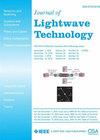Probabilistic Shaping Distributions for Optical Communications
IF 4.1
1区 工程技术
Q2 ENGINEERING, ELECTRICAL & ELECTRONIC
引用次数: 0
Abstract
Probabilistic shaping is widely employed in local oscillator-based coherent optical systems to improve receiver sensitivity and provide rate adaptation. This widespread adoption has been enabled, in part, by simple closed-form solutions for the optimal input distribution and channel capacity for these standard coherent channels. By contrast, the optimal input distributions and channel capacities for many direct-detection optical channels remain open problems. The lack of non-negative root-Nyquist pulses, signal-dependent noise, and the possible discreteness of the capacity-achieving input distribution have historically prevented standard information-theoretic techniques from obtaining simple closed-form solutions for these channels. In this tutorial, we review a high-rate continuous approximation (HCA) for analytically approximating the optimal input distribution. HCA, which was first developed for source coding, approximates the input constellation by a dense high-dimensional coset code that can be approximated well by a continuum, transforming the problem of computing the optimal input distribution subject to an average-power constraint to a problem of finding a minimum-energy shaping region in a high-dimensional continuous space. HCA yields closed-form continuous approximations to the capacity-achieving input distributions and shaping gains at high signal-to-noise ratio. We explain how enumerating a coset code in natural coordinates enables extension of HCA to direct-detection optical channels, allowing one to obtain closed-form approximations for the capacity-achieving input distributions and shaping gains for a variety of direct-detection systems that detect the intensity or Stokes vector and are limited by thermal or optical amplifier noise. We also discuss the implementation of probabilistic shaping in direct-detection systems.求助全文
约1分钟内获得全文
求助全文
来源期刊

Journal of Lightwave Technology
工程技术-工程:电子与电气
CiteScore
9.40
自引率
14.90%
发文量
936
审稿时长
3.9 months
期刊介绍:
The Journal of Lightwave Technology is comprised of original contributions, both regular papers and letters, covering work in all aspects of optical guided-wave science, technology, and engineering. Manuscripts are solicited which report original theoretical and/or experimental results which advance the technological base of guided-wave technology. Tutorial and review papers are by invitation only. Topics of interest include the following: fiber and cable technologies, active and passive guided-wave componentry (light sources, detectors, repeaters, switches, fiber sensors, etc.); integrated optics and optoelectronics; and systems, subsystems, new applications and unique field trials. System oriented manuscripts should be concerned with systems which perform a function not previously available, out-perform previously established systems, or represent enhancements in the state of the art in general.
 求助内容:
求助内容: 应助结果提醒方式:
应助结果提醒方式:


